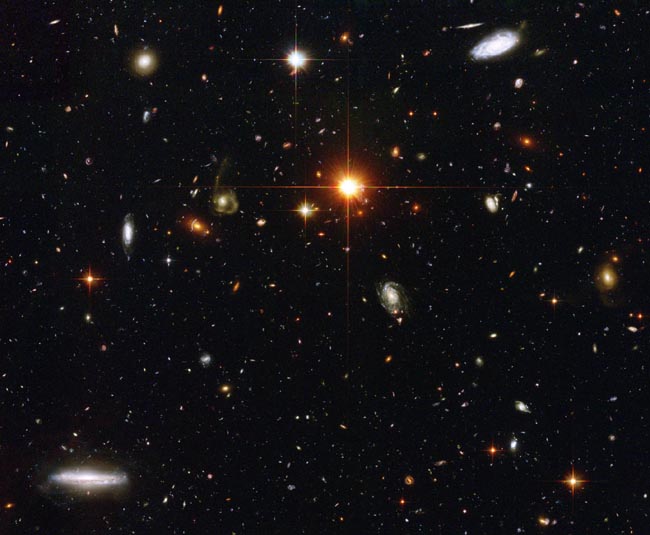
Description: Parallel Field to the HUDF NICMOS Observations
Position (J2000): R.A. 3h 32m 38s Dec. -27° 56' 53"
Constellation: Fornax
Dimensions: This image is 3.5 arcminutes across.
Instrument: ACS/WFC
Exposure Date(s): September 2003
Exposure Time: 39.6 hours
Filters: F435W (B), F606W(V), F775W (i), and F850LP(z)
Image Credit: NASA, ESA and The Hubble Heritage Team (STScI/AURA)
Release Date: August 4, 2005
ABOUT THIS IMAGE:
Gazing deep into the universe, NASA's Hubble Space Telescope has spied a menagerie of galaxies. Located within the same tiny region of space, these numerous galaxies display an assortment of unique characteristics. Some are big; some are small. A few are relatively nearby, but most are far away. Hundreds of these faint galaxies have never been seen before until their light was captured by Hubble.
This image represents a typical view of our distant universe. In taking this picture, Hubble is looking down a long corridor of galaxies stretching billions of light-years distant in space, corresponding to looking billions of years back in time. The field shown in this picture covers a relatively small patch of sky, a fraction of the area of the full moon, yet it is richly populated with a variety of galaxy types.
A handful of large fully formed galaxies are scattered throughout the image. These galaxies are easy to see because they are relatively close to us. Several of the galaxies are spirals with flat disks that are oriented edge-on or face-on to our line of sight, or somewhere in between. Elliptical galaxies and more exotic galaxies with bars or tidal tails are also visible.
Many galaxies that appear small in this image are simply farther away. These visibly smaller galaxies are so distant that their light has taken billions of years to reach us. We are seeing these galaxies, therefore, when they were much younger than the larger, nearby galaxies in the image. One red galaxy to the lower left of the bright central star is acting as a lens to a large galaxy directly behind it. Light from the farther galaxy is bent around the nearby galaxy's nucleus to form a distorted arc.
Sprinkled among the thousands of galaxies in this image are at least a dozen foreground stars that reside in our Milky Way Galaxy. The brightest of these foreground stars is the red object in the center of the image. The stars are easily discernable from galaxies because of their diffraction spikes, long cross-hair-like features that look like they are emanating from the centers of the stars. Diffraction spikes are an image artifact caused by starlight traveling through the telescope's optical system.
This image is a composite of multiple exposures of a single field taken by the Advanced Camera for Surveys. The image, taken in September 2003, was a bonus picture, taken when one of the other Hubble cameras was taking photos for a science program. This image took nearly 40 hours to complete and is one of the longest exposures ever taken by Hubble.
For additional information, please contact:
Keith Noll, Hubble Heritage Team, Space Telescope Science Institute, 3700 San Martin Drive, Baltimore, MD 21218, (phone) 410-338-1828, (fax) 410-338-4579, (e-mail) noll@stsci.edu.
John Blakeslee, Department of Physics and Astronomy, Johns Hopkins University, 3400 N. Charles Street, Baltimore, MD 21218, (cell phone) 410-967-1204